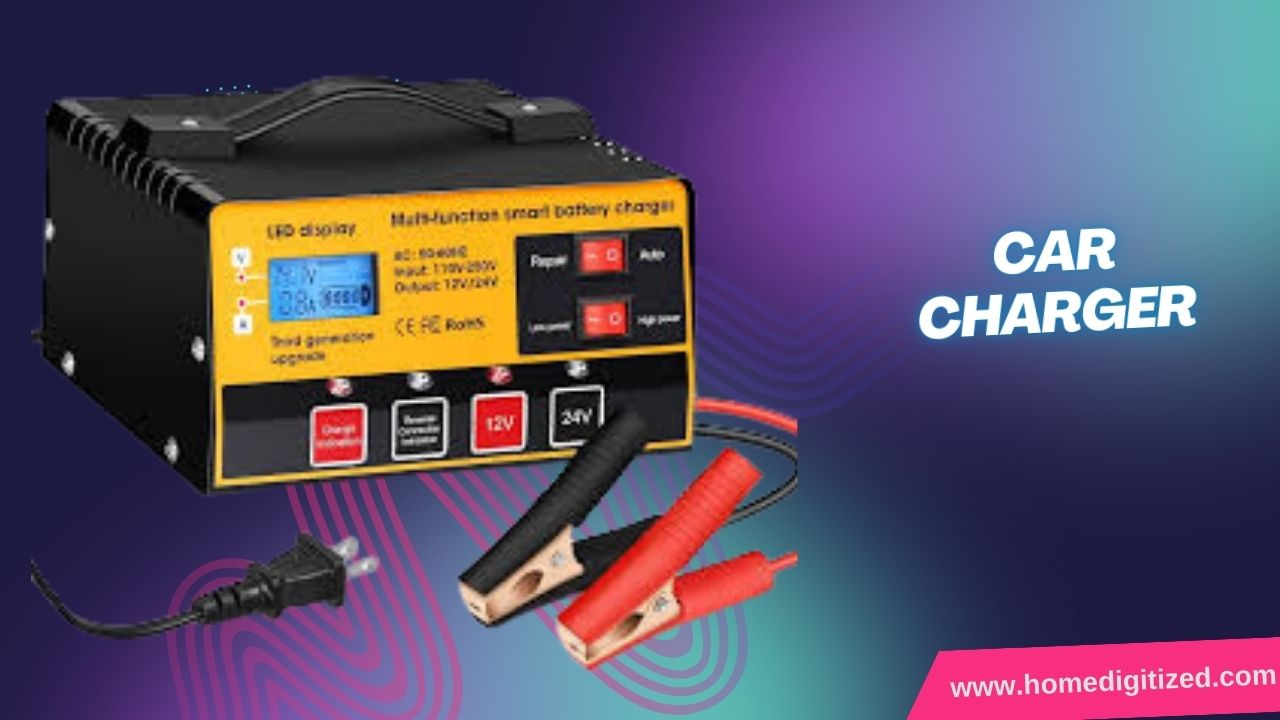I Tested AutoZone’s Automotive Battery Chargers Here’s What You Should Know
Today’s automotive battery chargers and electric vehicle (EV) chargers are more advanced than before.
Whether you’re using a regular automobile battery charger, a ChargePoint charger, or another sort of battery charger, one thing remains consistent: the usage of colored indicators to indicate the device’s condition.
But what do these hues truly represent? Understanding what each hue symbolizes will help you make smarter decisions while using your charger, avoiding misunderstanding and mistakes that could harm your vehicle or charger.
In this post, we will discuss the importance of the colors displayed on a car battery charger, a ChargePoint charger, and other battery chargers. We’ll also look at the meaning behind brand-specific colors employed by manufacturers.
What Do the Colors Mean on a Car Battery Charger?
A color-coded system is used by car battery chargers, especially the more recent, intelligent, or automated chargers, to assist users in monitoring the charging process. The charging cycle’s state is shown by the various colors, which helps customers determine if the battery in their car is fully charged or if there is a problem that needs to be fixed. We’ll go over the most popular color codes and their meanings below:
- Red Light: Ongoing Charging
Generally speaking, a red light on your automobile battery charger indicates that the charging process is underway. When your automobile battery is being charged, this is the most typical color you will notice. Usually, the red light indicates that:
It’s charging the battery.
The battery is being actively charged by the charger.
The pace of charging is rapid or consistent.
The battery may require a longer charging cycle if the LED stays red for a prolonged amount of time. A flashing red light may occasionally also be a sign of a problem with the battery or the charger. To guarantee correct charging, it is essential to consult the charger’s handbook.
Fully Charged Green Light
Usually, a green light will appear on the charger after the automobile battery is fully charged. This hue signifies:
- The battery has reached its optimal charge level.
- Charging is complete, and no further energy is needed.
- It’s safe to disconnect the charger.
A solid green light usually means everything is functioning well. However, if the charger switches from red to green too quickly, it may be worth checking the battery health. Some advanced chargers even have a “float charge” or maintenance mode after reaching 100%, to ensure the battery remains topped off without overcharging.
Yellow or Amber Light: Charging is Slow or Paused
When you see a yellow or amber light, it typically means that the charging process is slower than usual. This could be due to several factors, such as:
- Temperature: Extreme cold or hot weather can impact the charging rate.
- Battery Condition: A battery in poor condition may charge slower than usual.
- Charger Settings: Some chargers have specific modes, like “winter mode,” that charge the battery more slowly to prevent damage.
If the light stays yellow for a prolonged period, you may want to check if the charger has any settings that need to be adjusted or if the battery’s condition is affecting its charging speed.
Flashing Red or Orange: Error or Fault
A flashing red or orange light on your charger typically indicates a problem with the charging process. It could mean:
- The battery is not charging properly.
- The battery may be deeply discharged, faulty, or dead.
- There may be a problem with the charger, such as incorrect connections or a short circuit.
In these cases, it’s important to stop the charging process immediately and troubleshoot the issue. First, check the connection between the charger and the battery. If the light continues to flash, it might be time to consult the charger’s manual for further troubleshooting steps.
What Do Colors Mean on ChargePoint Chargers?
ChargePoint is one of the largest and most recognized networks for electric vehicle (EV) charging. ChargePoint chargers also use color indicators to show the status of the EV charging process. Understanding what the different colors mean can help EV owners get the most out of their charging experience. Below, we explain the most common color indicators you’ll see on a ChargePoint charger.
Green Light: Charging Complete
A green light on a ChargePoint charger typically indicates that the EV has completed its charging cycle. When this light is illuminated:
- The battery is fully charged.
- It’s safe to unplug your vehicle.
- The charger is no longer providing power to the vehicle.
This is the ideal color to see, as it signifies that your vehicle is ready to go and you can safely disconnect it.

Yellow or Amber Light: Charging In Progress
When the light is yellow or amber, it means that the charging process is ongoing. This indicates that the charger is actively providing power to the EV’s battery. The vehicle is still in the process of being charged, and the light will typically turn green once the battery reaches its full charge.
Red Light: Charger Error or Fault
A red light on a ChargePoint charger indicates that there is an issue with the charging session. It could mean:
- There’s a problem with the charger’s connection to your car.
- There’s a fault in the vehicle’s battery.
- The charging station has experienced an error.
If you encounter a red light, try disconnecting and reconnecting the charger. If the issue persists, it may be necessary to contact ChargePoint’s customer support for assistance.
4. Blue Light: Ready for Use
A blue light typically indicates that the ChargePoint charger is in a ready state, waiting for a vehicle to be plugged in. The charger is powered on but isn’t currently charging any vehicle. When you plug in your EV, the light will change to yellow or amber to indicate that the charging process has started.
What Are the Colors of Battery Chargers?
The colors on battery chargers—whether they’re designed for cars, motorcycles, or small electronics—are essential for understanding the charger’s status. Each color provides a visual cue that helps users understand what’s happening with the charging process. Here’s a deeper dive into what various charger colors mean:

Green Light: Fully Charged or Standby Mode
As mentioned before, green often signifies a fully charged battery. However, many chargers also use a green light to show that the charger is in standby mode. In this state:
- The charger isn’t actively charging, but it’s ready to begin charging when needed.
- This green light may be seen on battery chargers for a variety of vehicles or devices once the battery is at full capacity.
Red Light: Active Charging or Error
The red light on a charger typically means the battery is in the process of charging. But it can also indicate an error or fault condition, depending on the charger’s design. If the charger remains red for too long, it might indicate that:
- The battery is charging, but it’s in a critical state and needs extra attention.
- The charger has detected a fault with the battery.
Key Features of Car Battery Chargers
| Feature | Description |
|---|---|
| Type of Charger | Automatic, Manual, Smart, Trickle, and Solar chargers |
| Charging Speed | Varies from slow (trickle) to fast (quick-charge) depending on the model |
| Voltage Compatibility | Typically 6V, 12V, and 24V; ensure it matches your car battery’s voltage |
| Amperage Rating | Affects how quickly the charger can replenish a battery; typically 2-10A |
| Safety Features | Short circuit protection, overcharge protection, reverse polarity protection |
| Portability | Some chargers are compact and portable, others are designed for fixed setups |
| Battery Maintenance | Some chargers offer features like desulfation and maintenance modes for longer battery life |
| Price Range | From budget-friendly options around $20 to premium models up to $200+ |
FAQs (Frequently Asked Questions)
How do I know which car battery charger is right for my car?
- Make sure to check your vehicle’s battery voltage (usually 12V or 24V). Choose a charger that matches this voltage and is compatible with the battery type (e.g., AGM, Lead-acid, Lithium). Amperage rating should be considered based on how fast you need the charge.
Can I leave my car battery charger plugged in overnight?
- Many modern car battery chargers are “smart” and will automatically stop charging once the battery is full. However, it’s always recommended to monitor the process if you’re unsure of the charger’s features.
What is the difference between a trickle charger and a fast charger?
- A trickle charger delivers a low charge rate over an extended period, ideal for maintaining battery charge. A fast charger delivers a higher charge rate, recharging the battery in less time, but it may not be as gentle on battery health in the long run.
Can a car battery charger work on all types of car batteries?
- Most chargers are designed for standard lead-acid batteries, but you must ensure the charger is compatible with specialized battery types like AGM, GEL, or lithium batteries.
Why does my car battery die even after charging it?
- Possible reasons include a faulty alternator, corroded battery terminals, or an aging battery that can no longer hold a charge. It may also indicate that the charger you are using isn’t working properly or isn’t suited for your battery type.
What safety precautions should I take when using a car battery charger?
- Always read the manufacturer’s instructions. Ensure the charger is suitable for your battery’s voltage. Avoid using chargers in wet environments and keep them away from flammable materials. Additionally, disconnect the battery from the vehicle to avoid electrical surges.
Yellow or Amber Light: Slow Charge or Maintenance Mode
Some chargers may use yellow or amber lights to indicate a slower charge or maintenance mode. This color may indicate:
- The charger is working at a slower speed to prevent overcharging.
- The battery needs more time to reach full capacity, possibly due to age or temperature fluctuations.
- The charger has specific settings, like a trickle charge mode, to maintain battery health over long periods.
What Are the Charger Brand Colors?
Beyond the colors that indicate the status of the charging process, many charger manufacturers use specific colors to represent their brand’s identity. For example, YONHAN chargers often feature a bold red design, symbolizing energy and power. The color choices used by a brand help create a visual identity that communicates reliability, strength, and performance.
Here’s a quick look at some popular charger brand colors:
- YONHAN (Red): Represents power and reliability. YONHAN’s red chargers are designed to be striking and high-energy.
- NOCO (Black and Green): NOCO chargers use a combination of black and green to signify power and efficiency. Black represents strength, while green indicates a safe and complete charge.
- Schumacher (Black and Yellow): Schumacher chargers use black and yellow for high visibility and energy. Black represents sophistication, while yellow adds a touch of caution.
Brand colors go beyond just aesthetics—they are an essential part of creating a connection with the user and establishing trust.

Understanding the meanings behind the colors on car battery chargers, ChargePoint chargers, and other battery chargers can make a significant difference in how you maintain your vehicle’s battery health. These color codes are essential for ensuring a smooth charging experience and preventing unnecessary errors.
Always pay attention to the color indicators to determine whether your battery is charging, fully charged, or experiencing an issue. Additionally, knowing the colors associated with popular charger brands can help you choose the right charger for your needs and make the most of your charging experience.






